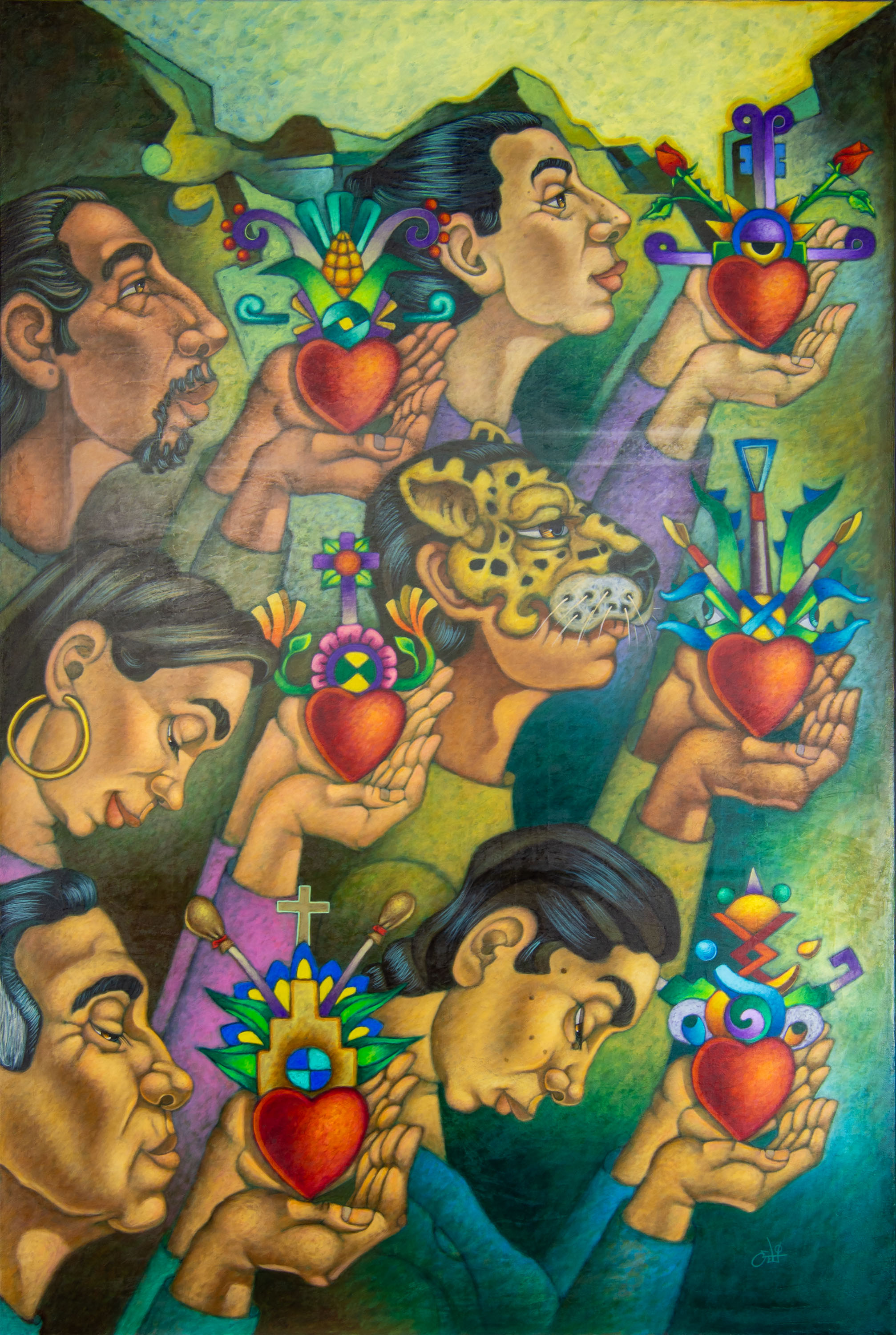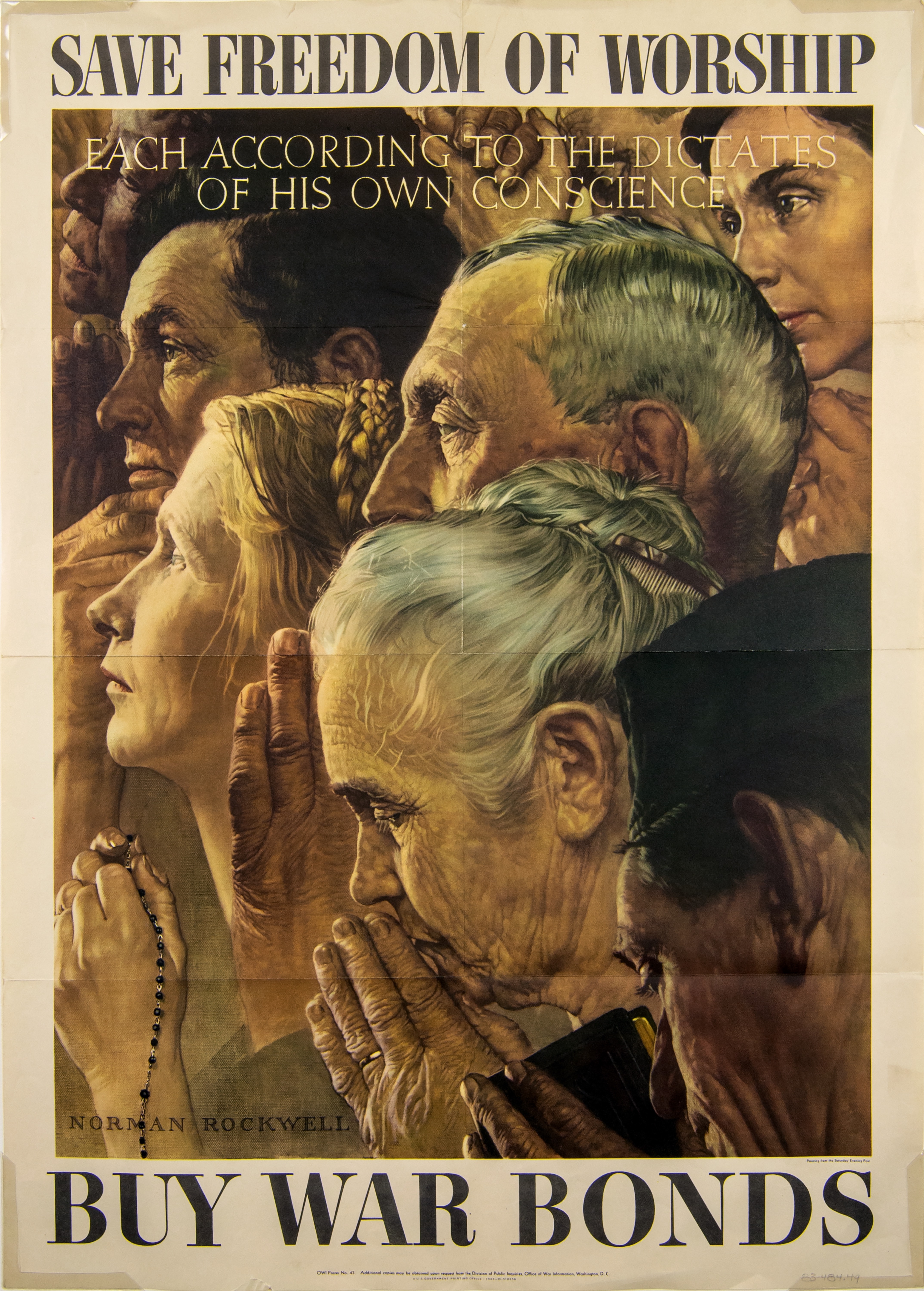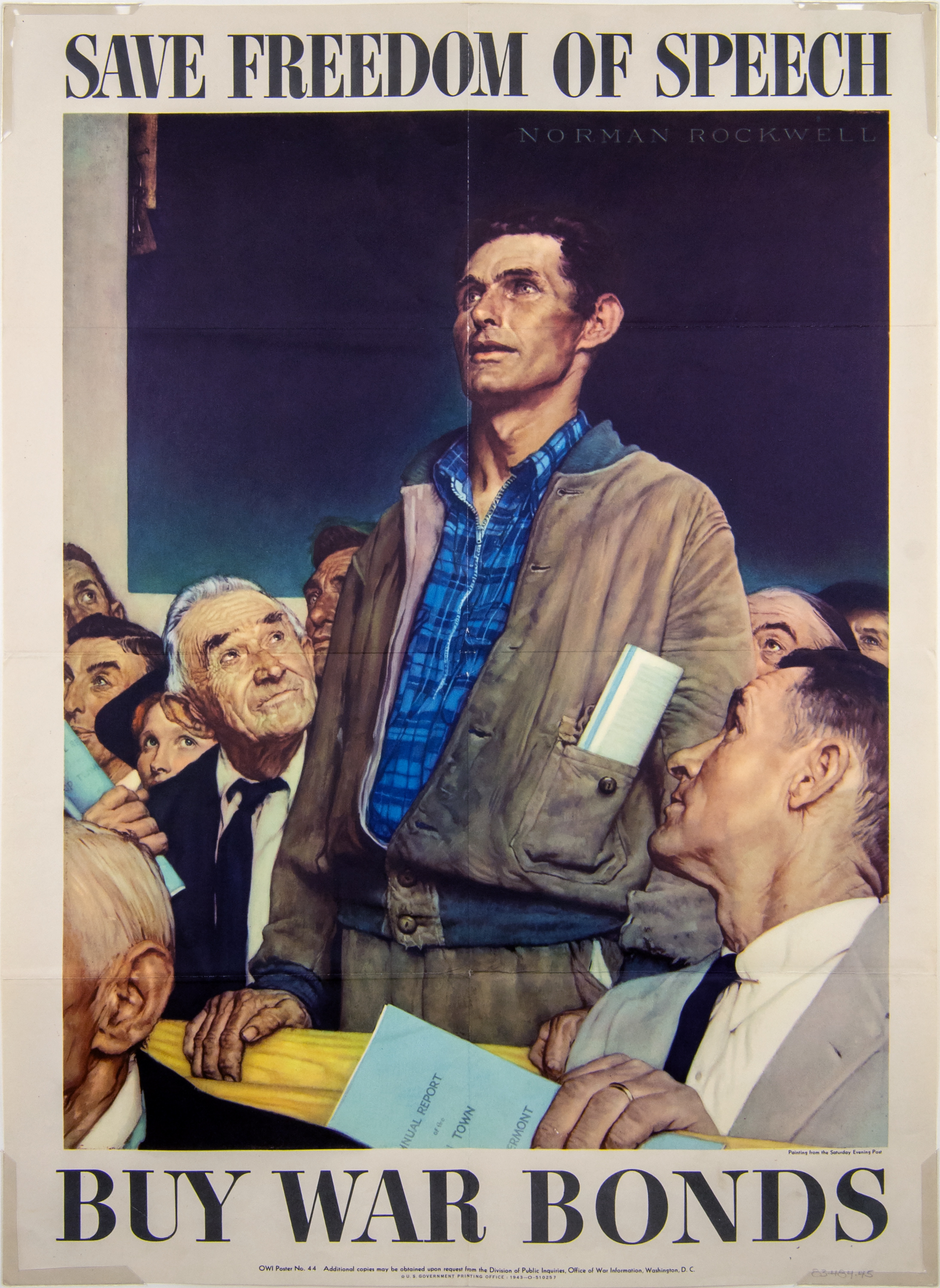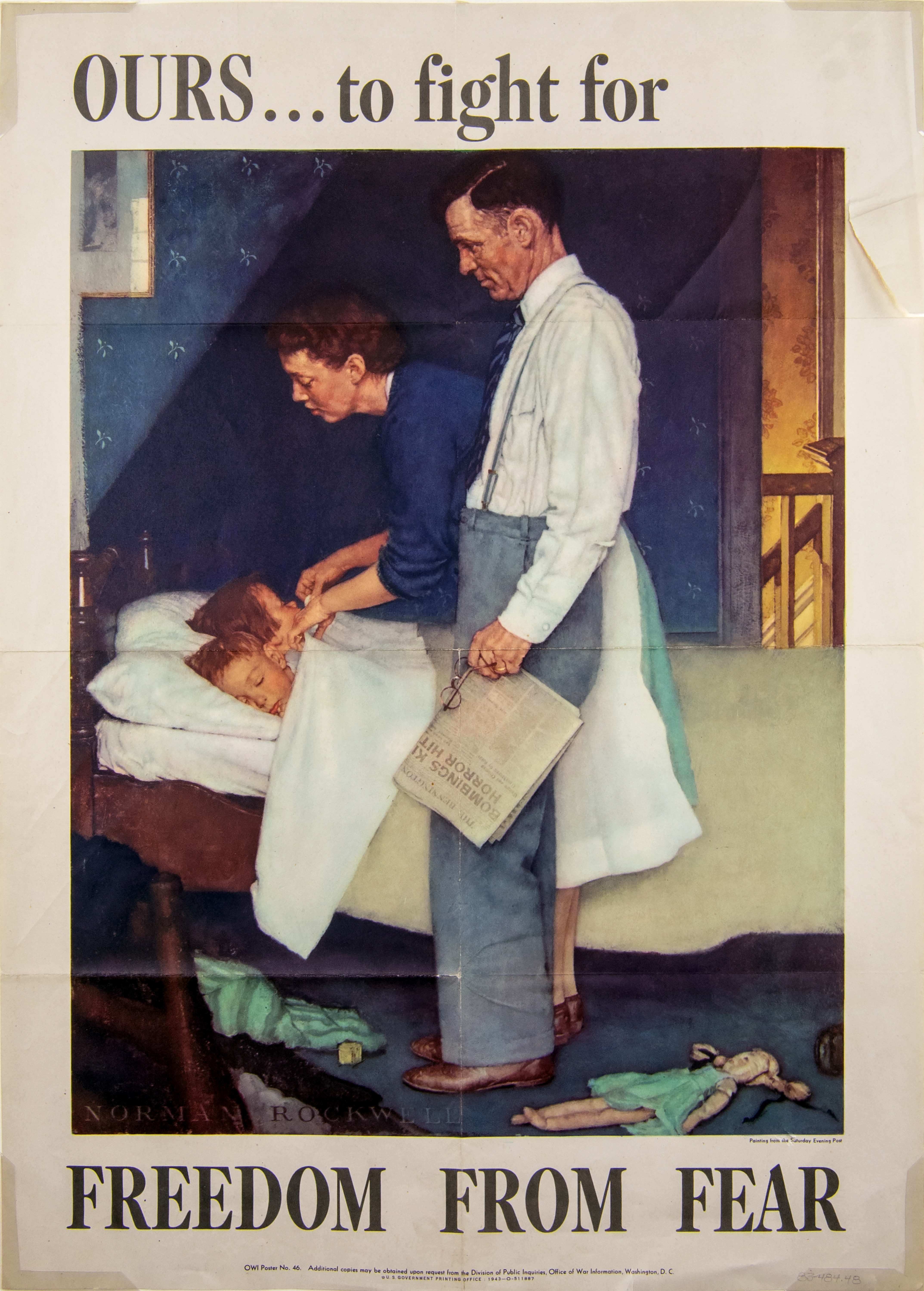
Story
“Is America Possible?”
The Space Between David Ocelotl Garcia’s and Norman Rockwell’s Freedom of Worship
An anthropologist, educator, and Chicano/a murals scholar looks at artist David O. Garcia's dynamically colorful reimagining of Norman Rockwell's 1940s-era Freedom of Worship.
A mountainous and pyramid-like terrain is set in the distance of David Ocelotl Garcia’s creative interpretation of Norman Rockwell’s Freedom of Worship. Rockwell’s original monochromatic grey-hued painting from 1943 features human forms tightly assembled in profile with hands in prayer facing towards the left of the canvas.1 Religious objects—a rosary, a wedding ring, and a book of worship—can also be discerned. In Garcia’s interpretation, commissioned by History Colorado for its installation of the Smithsonian exhibition American Democracy: A Great Leap of Faith, the land appears to give rise to six human forms placed in the foreground, each holding and offering their unique blossoming hearts to what is just out of view to the right of the canvas. Garcia’s Freedom of Worship is a personal meditation on spirituality told through color, form, and elements of Chicana/o muralism. The historical space between the two highlights erasure and affirmation within American society and provides space to reflect on the future.
Garcia’s murals, paintings, and sculptures can be found throughout Denver and beyond. Born and raised among Denver’s multiracial communities, Garcia and I discussed his artistic process and his commissioned painting over two conversations. Our first took place one Saturday morning in September at Denver’s History Colorado Center, where Garcia, Lucha Martinez de Luna (History Colorado’s Associate Curator of Latino Heritage and founding director of the Chicano/a Murals of Colorado Project), and I explored the American Democracy exhibit.
Our walkthrough elicited numerous comments, but it was Garcia’s comment regarding Rockwell’s use of color in Freedom of Worship that frames the conversation before you. Garcia explained that color is one of the techniques he favors in his artistic expressions because of its emotive qualities. Colors’ ability to inspire emotions in the viewer, he explained, reveals that color is imbued with energy, and energy is at the core of Garcia’s worldview and of his abstract imaginism—his use of technique, color, and composition to manifest what moves as energy in the material world and in the imagination. Consequently, Garcia shared how he had been struck by the absence of color in Rockwell’s painting, which was especially pronounced when placed among the other Freedoms in the series.
We returned to this topic in our second conversation, when we discussed how Rockwell’s elimination of color gestured towards a diversity of faiths as fundamental to American democracy. We further discussed how perhaps this also gestured towards a vision of a colorblind, separate-but-equal society, which, in Rockwell’s time, was still racially segregated by law and would continue to be so until after World War II.
Rockwell’s Freedom of Worship features seven heads crowded together in repose with three figures dominating the space. The remaining four figures on the canvas include an African American woman who can barely be discerned in the top left corner. As Bridget R. Cooks, art historian and scholar of African American studies, writes, “Rockwell’s awkward tilt of her head positions her profile so close to the picture’s edge that she seems to have just made it onto the page. She is tightly compressed into the shallow representational space with a group of figures Rockwell painted to show a diversity of faiths.” Further obscuring her presence are the words “Each According To The Dictates of His Own Conscience” at the top of the canvas. Cooks helps us understand how Rockwell’s oeuvre ultimately portrays “white national unity” given his engagement of African American figures throughout the span of his career. While Rockwell used models to capture his iconic realism, this realism belies reality as his narrative of America equates equality with diversity, significant given the logic of elimination as a framing principle of settler colonialism.
Although Garcia emphatically explained that he does not make overt political statements in his art, he inevitably partakes in a politicized landscape since he affirms lifeways that have continuously been denied and erased in American society. (Of note is that Garcia’s first exterior mural, Huitzilopochtli of 2009, was whitewashed and erased earlier this year in violation of the Visual Artists Rights Act of 1990.) The viewer of Garcia’s Freedom of Worship may be drawn to a central figure wearing a mask of a jaguar, or ocelotl in Nahuatl. This figure, Garcia explained, represents himself and affirms his spirituality and beliefs in Indigenous lifeways. His worldview, he said, is grounded in Indigenous lifeways, aesthetics, and symbolism, specifically Mexica, which he first began exploring at home through his father’s copy of the Codex Nuttall and later through his participation in Denver’s Chicana/o communities. Indigeneity among Mexican-descent populations and communities is complex, but the holding of space for Indigenous lifeways, including Mexica-embodied practices of dance, storytelling, symbolism, and the Nahuatl language, is a response to colonization and assimilationist efforts that seek to erase and eliminate these knowledges and practices.
When Rockwell painted Freedom of Worship, US tribal Indigenous nations were not legally permitted the freedom of worship, and racially segregated US combat units fought and lost lives in defense of freedom and democracy and against growing fascism on European soil. This hypocrisy was a catalyst for social and racial justice movements of the mid-twentieth century, which led to judicial, political, educational, and cultural changes in pursuit of racial, economic, and gender equality. Garcia’s inclusion in a cultural institution’s exhibition on American democracy is demonstrative of this effort but still politicized given museums’ and cultural institutions’ enduring legacy as institutions that have historically excluded racialized others as visionaries of, and as belonging to, the nation.
In the decade leading up to the signing of the American Indian Religious Freedom Act of 1978, members of Denver’s Chicana/o community used public spaces to express their presence and grievances against an oppressive government that did not protect and invest in their communities and instead continually favored their displacement and criminalization while ignoring their histories and contributions to the history of Colorado. One telling example took place in 1936, when Colorado Governor Edwin C. Johnson created an international stir because of his anti-Mexican position (against both New Mexicans, who were American citizens, and Mexican nationals), which he constructed as a defense of American, i.e. white, laborers.2 But absent from his position was the articulation that a migration pattern between New Mexico and Colorado had been created after US annexation had dispossessed former Mexican nationals and then American citizens of those lands through a litigation system foreign to them.
World War II would see an increase in Mexican migration to Colorado and other parts of the United States as the Bracero Program, a series of laws and agreements between Mexico and the United States established in 1942, recruited Mexican laborers to work US agricultural fields, creating new networks and communities of Mexican-descent peoples in the United States.
These histories are seldom affirmed in official historical narratives, but art, inside and outside of gallery walls, does so in spite of and because of constant threats of erasure.3 Garcia’s Freedom of Worship affirms the self and the people in his community, whose knowledge and passions are shared and kept alive through memory and practice, while also honoring the Mexican-descent peoples’ relation to land as herencia, or heritage—much like Chicana/o muralists in Colorado have historically done on exterior and interior walls in public spaces.4
Garcia explained that for this project he began with a meditation on worship and the role of spirituality in his life, which led him to recognize his art as a spiritual practice reliant on faith and passion. He also shared that he had not been surprised that chance had granted him Freedom of Worship to reinterpret, given that it features profile imagery, one of Garcia’s favorite creative manifestations. He elaborated:
I love profile imagery of people because when you look forward, you only see a certain part of the lines of your face. A three-quarter view is a little better because you can see more of the nose structure and face structure. But from the profile, it’s just this amazing organic line that travels around a person’s face and even their body.5
Lines, for Garcia, capture movement and the essence of energy, while angles capture depth—aspects of his work that he describes as abstract imaginism.
Garcia’s artistic process relies on the self, intuition, and instinct, which he recognizes as energy and hence as an abstraction in part because of the difficulty in defining it and imaginism because it requires disconnecting from the physical world and materializing what lies in the mind. His exploration of lines and their movement results in a distortion and the creation of figures that resemble caricatures but retain a realism—for they invoke a feeling, a curiosity, an energy within the viewer. Garcia’s abstract imaginism affirms the existence of energy that lies within each one of us and within our communities, while the historical space between the two works of art suggests that manifesting and achieving a more perfect union, which has been structured by racializations and the logic of elimination, is a persistent work in progress.
Sources
Bridget R. Cooks, “Norman Rockwell’s Negro Problem.” Cultural Critique 105 (fall 2019), 40– 79.
Karen Mary Davalos, Exhibiting Mestizaje: Mexican (American) Museums in the Diaspora (Albuquerque, University of New Mexico Press, 2001).
Patrisia Gonzales, Red Medicine: Traditional Indigenous Rites of Birthing and Healing (Tucson: University of Arizona Press, 2012).
Dwanna L. McKay, Kirsten Vinyeta, and Kari Marie Norgaard, “Theorizing Race and Settler Colonialism within U.S. Sociology.” Sociology Compass 14 (2020).
Lucha Martinez de Luna, “Chicano Murals in Colorado: The First Decade.” Colorado Heritage, September/October 2015 (Denver: History Colorado, 2015).
Notes
1 Rockwell illustrated President Franklin Delano Roosevelt’s 1941 vision of a postwar society based on the democratic ideals of the freedoms of worship and speech and the freedoms from fear and want. Rockwell’s Four Freedoms first appeared in The Saturday Evening Post and were then circulated by the U.S. Department of the Treasury to sell war bonds and stamps as a war effort. Rockwell’s Four Freedoms went on exhibition earlier this year at the Denver Art Museum.
2 History Colorado’s Lost Highways: Dispatches from the Shadows of the Rocky Mountains podcast shares some of this history in the episode “A Line in the Sand.”
3 Between 1968 and 1978, sixteen Chicana/o/x murals, five interior and eleven exterior murals, made claims to public space, but only three remain visible.
4 Garcia specifically honors Kasi Garcia (his wife), Melissa Ortiz, Eduardo Sandoval, Siri Martinez, and Adrianna Abarca.
5 This quote has been edited slightly for clarity.
The author borrowed her title, “Is America Possible?,” from an interview with Vincent Harding in the On Being with Krista Tippett podcast and his essay of the same name. Harding was active in the Civil Rights Movement and chaired the Veterans of Hope Project at Denver’s Iliff School of Theology. He reminds us that the movement was also a deeply spiritual one and that hope can be found in our youth, who are the future.
More from The Colorado Magazine
A Big, Complex, and Incomplete Story of the Vote In the fall of 2018, I started working on plans to commemorate the 100th anniversary of the 19th Amendment. As we mark this occasion on August 26, what I thought would feel like an ending to this work feels like just the beginning.
1904: The Most Corrupt Election in Colorado History Between stuffed ballot boxes, election clerks hopping off trains, and three governors in a day, Devin Flores might just have a point.
Colorado Is My Classroom More than a century ago, open-air classrooms had a moment in response to another pandemic. Then it was tuberculosis, another era-defining airborne pathogen that attacked the respiratory system. And the results were encouraging. Could fresh air be part of the solution to school in the time of coronavirus?





